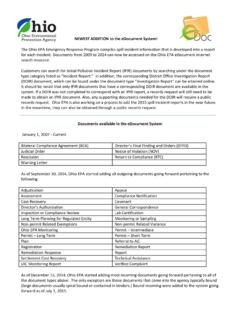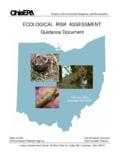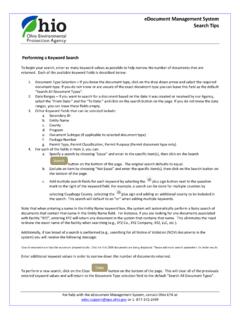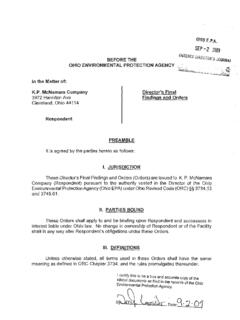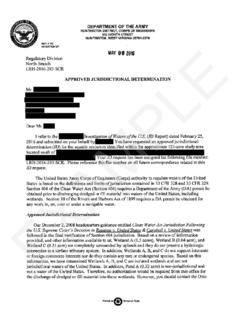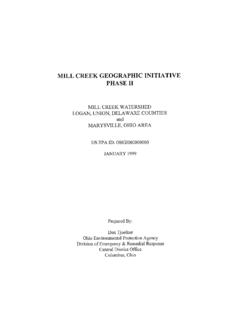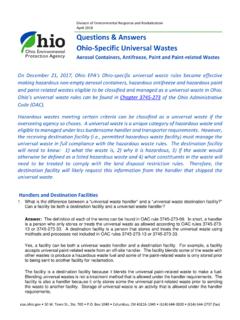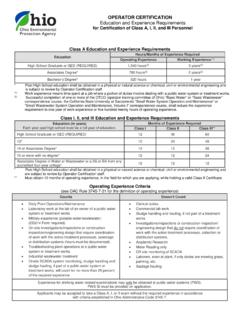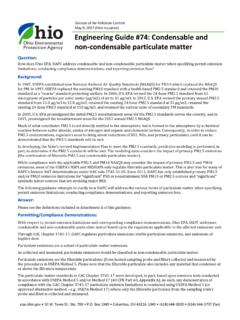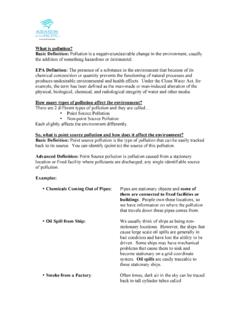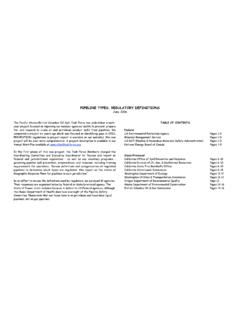Transcription of Understanding the Spill Prevention, Control and ...
1 50 W. Town St., Ste. 700 Box 1049 Columbus, OH 43216-1049 (614) 644-3020 (614) 644-2737 (fax) Division of Environmental and Financial Assistance February 2017 Understanding the Spill prevention , Control and Countermeasure (SPCC) Requirements EPA oversees compliance with the SPCC program. If you have specific questions about your compliance requirements, contact EPA s Region 5 Office. If you store oil or oil products, you could be subject to the Spill prevention Control and Countermeasure (SPCC) regulations. These federal regulations (40 CFR Part 112) require that certain procedures, methods and equipment be used to prevent and contain discharges of oil or petroleum products. This includes the development of a Spill prevention and response plan. The SPCC regulations apply to non-transportation-related facilities that store oil or petroleum products in greater than threshold quantities and, due to facility location, a discharge could reasonably be expected to reach a waterway (including sewer pathways).
2 How do I know if my facility is subject to the SPCC regulations? First, you need to determine the oil storage capacity at your facility. If you have any of the following storage capacities, you are subject to the SPCC regulations: a total aboveground storage capacity of greater than 1,320 gallons; or a total underground storage capacity of greater than 42,000 gallons. This excludes tanks regulated by the State Fire Marshal s Bureau of Underground Storage Tank Regulations (BUSTR). What are examples of SPCC regulated facilities? Some examples of facilities commonly covered by the SPCC program are listed below; however, many other types of facilities may be subject to the regulations: vehicle maintenance and refueling facilities; facilities that use, store, produce, gather or process oil or petroleum products; oil drilling, production and refining facilities; waste treatment facilities; loading areas/racks, transfer hoses, loading arms and other equipment which are part of a non-transportation-related facility; highway vehicles and railroad cars used to transport oil within the confines of a non-transportation-related facility; or pipeline systems used to transport oil exclusively within the confines of a non-transportation-related facility.
3 Are there any exemptions? The following are exempt from the SPCC regulations. Some transportation-related activities. These include highway vehicles, railroad cars, pipelines and breakout storage tanks needed for the continuous operation of a pipeline. Transportation facilities used for routine on-site storage may not be exempt. Containers less than 55 gallons. Containers that meet the SPCC definition of permanently closed. Underground storage tanks regulated in Ohio by BUSTR or licensed by the Nuclear Regulatory Commission. Tanks used exclusively for wastewater treatment. The production, recovery or recycling of oil is not considered wastewater treatment. Hot mix asphalt. Under the SPCC regulations, the definition of oil is very broad and includes animal, vegetable and synthetic oils. Other common oil and petroleum products that are regulated include heating oil, crude oil, mineral oil, gasoline and diesel fuel. Storage tanks in basements are considered aboveground storage tanks rather than underground storage tanks.
4 Additionally, you must consider the total capacity of your tanks and containers, not the actual amount being stored or portion commonly used. Containers of less than 55-gallons in size do NOT need to be included in calculating SPCC storage capacity. Understanding the Spill prevention , Control and Countermeasure (SPCC) Requirements Page|2 Residential heating oil. Pesticide application and mixing. Onboard bulk storage containers used to power the movement of a motor vehicle or ancillary onboard oil-filled operational equipment. Milk and milk product containers. How do I comply with the SPCC requirements? If you are subject to the SPCC rules, there are two basic requirements: provide adequate secondary containment for oil or petroleum product storage and transfer areas to contain any releases; and prepare and implement a written SPCC plan. However, there are other applicable requirements, so please consult the full text of the rule.
5 What is adequate secondary containment? There are two types of secondary containment sized secondary containment and general secondary containment. Sized secondary containment is only required for bulk storage containers, mobile/portable containers and loading racks. Sized secondary containment must be sized to the largest tank or container with enough freeboard for a rain event. While a specific freeboard requirement is not specified, the rule of thumb is 110 percent of the largest tank or container or a 25-year, 24-hour storm event, whichever is greater. General secondary containment only needs to address the typical failure mode of the system and only needs to account for the quantity that is likely to be spilled in the event of a failure. Additionally, general secondary containment can include passive containment such as a Spill kit and procedure to address a release. Appropriate containment for onshore facilities may include: impervious dikes, berms or retaining walls; curbing; culverts, gutters or other drainage systems; weirs, booms or other barriers; Spill diversion or retention ponds; or shop fabricated double-walled tanks meeting UL standards.
6 What are the requirements of a written SPCC plan? In addition to secondary containment, if you are subject to the SPCC regulations you must have a written SPCC plan. The SPCC plan must describe all measures taken at your facility to prevent and Control a release of oil or petroleum products, including but not limited to: facility operations, staffing, site security, Spill history and documentation of annual training for oil-handling employees; oil release scenarios that include possible volume of the Spill and the direction of flow; notification procedures, which must include an emergency call list and should include notification of nearby facilities that may be in the direction of flow and could be impacted by the release; a facility site plan showing areas of oil storage and transfer; a description of containment structures or equipment used to prevent releases; a description of the procedures to stop, contain and clean up any released materials, including procedures for managing collected rain water; oil storage inspection procedures.
7 A written commitment of manpower, equipment and materials to expeditiously Control and remove any amount of oil that may be spilled; and written procedures for integrity and leak testing of tanks, containers, valves and piping. Understanding the Spill prevention , Control and Countermeasure (SPCC) Requirements Page|3 The SPCC plan must be prepared and implemented before you begin operations and it must be updated every five years or whenever significant changes in oil storage occur. In addition, employees that handle oil must be trained on the contents of the SPCC plan. Unless you meet the requirements to self-certify your plan as described below, your SPCC plan must be signed by your management and must be certified by a professional engineer (PE) familiar with your facility, The PE is certifying that they are familiar with the SPCC requirements and that they or their agent have visited and examined your facility. Additionally, they are certifying that your SPCC plan has been prepared in accordance with the SPCC requirements and good engineering practices, that procedures for inspections and testing have been established, and that your plan is adequate for your facility.
8 You must document that your management has reviewed your plan every five years, even when there are no changes. Any technical modification to your plan also needs to be certified by a PE. Non-technical or administrative modifications, such as changes to the contact list or phone numbers, do not require a PE certification. Do I have to hire a PE to review and certify my plan? If you meet the following criteria, you are considered a Qualified Facility and may have the option to self-certify your SPCC plan instead of having your plan reviewed and certified by a PE (see box below). Have 10,000 gallons or less in aggregate aboveground oil storage capacity, and for the three years prior to your plan s certification date, you have not had discharges of oil to navigable waters of the or adjoining shorelines that exceed: o a single discharge of 1,000 gallons of oil from your facility; or o two discharges of more than 42 gallons of oil in a 12-month period.
9 If you have no individual aboveground containers greater than 5,000 gallons, you are considered a Tier 1 Qualified Facility and in addition to being able to self-certify you are eligible to use the EPA Plan Template included in Appendix G 40 CFR part 112. If you have any individual aboveground container greater than 5,000 gallons then you must prepare your self-certified plan, in lieu of a PE-certified Plan. However, if you want to use alternative methods that provide equivalent environmental protection, or if you have determined that secondary containment is impractical, then a PE will need to review and certify those aspects of your plan. You can still self-certify the remaining portions of your plan. Additionally, Qualified Facilities also have the option to use streamlined facility security and tank integrity inspections requirements. Are there sample SPCC plans I can look at when developing one for my operations? Yes. There are many resources to help you understand, develop and implement your SPCC plan, including plan templates from EPA s website.
10 You must have the plan certified by a professional engineer if engineering work is involved. If your SPCC plan is very simple in nature and does not require engineering work, you as the owner or operator may self-certify. Please contact the Ohio Board of Registration for Professional Engineers and Surveyors, EPA or see our SPCC fact sheet for more information. The plan is to be reviewed every five years, or whenever there is a change at the facility. The written SPCC plan must also be submitted to EPA whenever there is a Spill of 1,000 gallons or more, or two releases of more than 42 gallons each within a 12-month period. Understanding the Spill prevention , Control and Countermeasure (SPCC) Requirements Page|4 Does EPA or Ohio EPA approve my SPCC plan? With the exception of facilities subject to the Facility Response Plan (FRP) portion of the SPCC regulations, EPA does not approve your SPCC plan. Facilities subject to FRP must have their plans approved by EPA or the Coast Guard.
